Camellia Leaf Gall Disease - Learn About Leaf Gall On Camellias


There is no mistaking leaf gall on camellias. The leaves are most affected, exhibiting twisted, thickened tissue and pinkish green coloring. What is camellia leaf gall? It is a disease caused by a fungus. It can also affect young stems and buds, which affects flower production. For this reason, knowing effective camellia gall treatment is important.
What is Camellia Leaf Gall?
Camellias are proven winners with cool season blooms and glossy green leaves. The plants are relatively hardy and retain their vigor even in harsh conditions. Camellia leaf gall disease doesn't really affect the plant's vitality, but it will depreciate the beauty of the leaves and can reduce blooms. Fortunately, leaf gall on camellias is easy to treat as long as you learn the life cycle of the fungus and follow a few rules. The disfiguring disease stems from the fungus Exobasidium vaccinii. It is a fungus which overwinters in soil and is splashed up onto leaves or blown in on the wind. The fungus is host specific, although there are other species of Exobasidium that affect specific families of plant. The contamination occurs in fall and winter, and galls on camellia leaves form in spring. The affected tissue develops as small bumps, which conform to the regular plant tissue in color. As they get larger, the tissue turns pinkish, and gall can swell to up to an inch (2.5 cm.) in diameter.
Progression of Galls on Camellia Leaves
Galls can be single spots on a leaf or stem or infect the entire tissue. As the galls mature, they turn white on the underside. This is the fungal spores that have ripened inside the plant tissue and starts the life cycle over anew as the spores are dispersed. By late spring to early summer, galls on camellia leaves have turned brown and fallen off the main plant body. Any remaining spores lay dormant in the soil until rain or other mechanisms stir them up and plant them on susceptible plant tissue. Camellia leaf gall is most prevalent on Camellia sasanqua, but it can affect any plant in the genus.
Camellia Gall Treatment
No existing fungal spray is available for control of camellia leaf gall disease. If you have plants that are not affected, you can apply a preventative Bordeaux spray in early spring just at bud break. Pruning the plant to keep air and sunlight flowing through it is also helpful. It is important to catch the disease before the leaves turn white to prevent the spread of the spores. Removal and disposal of the affected plant parts is the best treatment. The fungus will likely persist in compost, which means any plant material must be put in the trash or burned. There are also some leaf gall resistant species to try planting in the landscape.
Gardening tips, videos, info and more delivered right to your inbox!
Sign up for the Gardening Know How newsletter today and receive a free download of our most popular eBook "How to Grow Delicious Tomatoes."

Bonnie Grant is a professional landscaper with a Certification in Urban Gardening. She has been gardening and writing for 15 years. A former professional chef, she has a passion for edible landscaping.
-
 Urban Composting Guide: How To Compost In The Middle Of The City
Urban Composting Guide: How To Compost In The Middle Of The CityUrban composting does not have to be daunting. You can compost in the city, and maybe even try some urban worm composting!
By Mary Ellen Ellis
-
 Shrub Diseases And Pests To Watch Out For
Shrub Diseases And Pests To Watch Out ForShrub diseases and pests can be challenging. Learn how to recognize and eradicate them before they can present a danger to your plants.
By Susan Albert
-
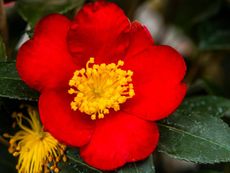 Yuletide Camellia: How To Grow And Care For Yuletide Camellias
Yuletide Camellia: How To Grow And Care For Yuletide CamelliasLearning more about the Yuletide camellia's care can help you decide whether or not this shrub is a good choice for your home landscape.
By Tonya Barnett
-
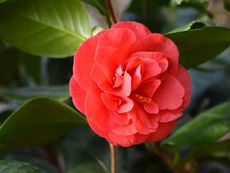 Indoor Camellia Care – How To Grow A Camellia Houseplant
Indoor Camellia Care – How To Grow A Camellia HouseplantCamellias are normally grown outdoors, but you can grow camellias indoors if you give them proper conditions. Learn more here.
By Raffaele Di Lallo
-
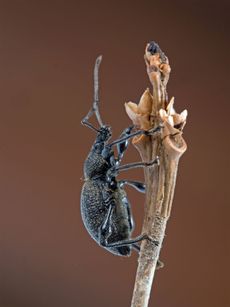 Holes In Camellia Leaves: Controlling Camellia Weevils And Beetles
Holes In Camellia Leaves: Controlling Camellia Weevils And BeetlesCamellias have gorgeous blooms but their beauty can be significantly marred by holes in camellia leaves. If your camellia plant has holes, it is most likely the result of the camellia vine weevil or cranberry rootworm beetle. Learn how to combat them here.
By Amy Grant
-
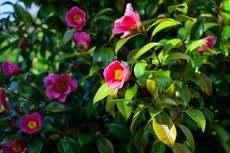 Camellia Companion Plants - What To Plant With Camellias
Camellia Companion Plants - What To Plant With CamelliasIf you’re wondering about suitable companions for camellias, keep in mind that while color and form are important, so too are growing habits. Many plants play nice with camellias, but others just aren’t compatible. Click here for tips on planting with camellias.
By Mary H. Dyer
-
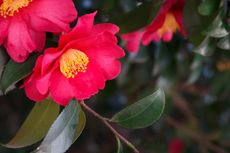 My Camellias Won't Bloom – Tips For Making Camellias Flower
My Camellias Won't Bloom – Tips For Making Camellias FlowerAlthough camellias are generally reliable bloomers, they can be stubborn at times. It?s frustrating, but sometimes, even healthy camellias won?t bloom. If you?re wondering how to make non-flowering camellia plants bloom, click here for more information.
By Mary H. Dyer
-
 Camellia Transplanting: Learn How To Transplant A Camellia Bush
Camellia Transplanting: Learn How To Transplant A Camellia BushIf your camellias outgrow their planting sites, you'll want to start thinking about transplanting camellias. Click here for information about camellia transplanting, including tips on how to transplant a camellia and when to move a camellia bush.
By Teo Spengler
-
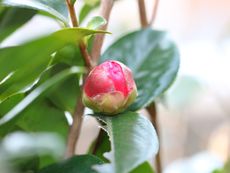 Tips On Treating Bud Mites On Camellias
Tips On Treating Bud Mites On CamelliasToday's camellias are easy-to-grow evergreen plants, as tough and rugged as they are beautiful. But that doesn't mean that camellia lovers shouldn't prepare for insect pests, like camellia bud mites. Click here for information about mites on camellia plants.
By Teo Spengler
-
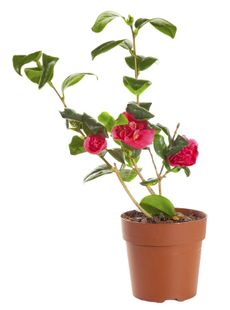 Camellia Container Care: How To Grow A Camellia In A Pot
Camellia Container Care: How To Grow A Camellia In A PotAlthough camellias can be somewhat picky about their growing conditions, container grown camellias are definitely possible. Learn how to grow a camellia in a pot using the information in the following article. Click here for more info.
By Mary H. Dyer